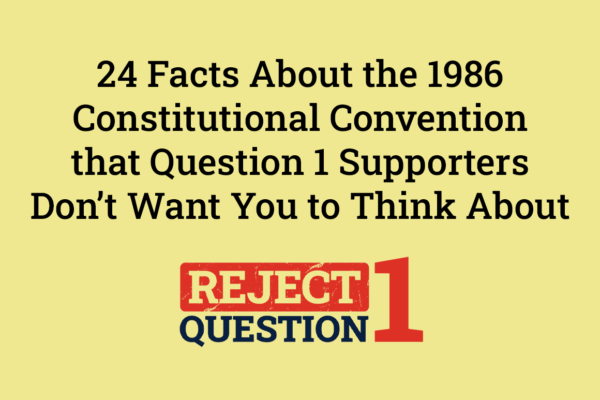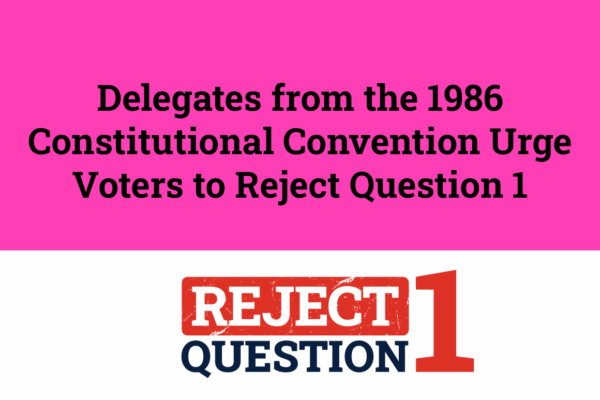On November 5, Question 1 on the ballot will ask voters if they wish to approve the calling of a state constitutional convention. The ACLU of Rhode Island strongly opposes this ballot question. Rhode Island held the last constitutional convention in the nation almost 40 years ago. The history of that convention teaches us that another convention presents a grave threat to civil rights and will divert resources from addressing critical issues facing our state. While convention supporters claim that Question 1 will allow for a “people’s convention” to bypass the politics of the General Assembly, the fact is that a convention will be as political as any legislative session, if not more so.
Here are some facts about a constitutional convention that supporters of Question 1 don’t want you to think about.
1985 RI CONSTITUTIONAL CONVENTION ELECTED DELEGATES
1. In the 1985 election to choose convention delegates, fewer than 18% of eligible voters went to the polls.
2. With multiple candidates running as delegates in many districts, only one-quarter of the delegates in 1986 were elected by majority vote. Almost half of the delegates were elected by fewer than 40% of those who voted, with one-fifth elected with fewer than 30% of the votes cast in their race.
LEARN MORE ABOUT BALLOT QUESTION 1
3. As a result of the combination of low voter turnout and the large number of candidates in some of the districts, some delegates may have been elected by fewer than 5% of the eligible voters in their district.
4. According to news reports at the time, the voters elected “about 40 delegates with distinct Democratic backgrounds and about 20 who have been active in Republican affairs,” including people then serving on city and town party committees.
5. The General Assembly kept its pledge that no sitting legislators would run as delegates. Instead, at least seven former legislators won seats to the convention, and at least four relatives of sitting legislators were elected, including the Speaker of the House’s son and sister.
6. In 1986, while the Constitutional Convention was still in session, 17 of the delegates filed to run for the General Assembly, at least 5 others filed to run for city or town council, and one filed to run for Governor.
1986 CONSTITUTIONAL CONVENTION PROCESS
7. Literally from beginning to end, the convention was mired in politics. Before it even started, the Democratic General Assembly and the Republican Governor fought over the timing of the convention — for political reasons, the Governor wanted it held in 1985 and the General Assembly wanted it held in 1986. Once the Convention was completed, politics played a role in deciding the order of questions on the ballot, with supporters of an anti-abortion amendment placing that controversial measure last (Number 14) in the hope of tamping down the “no” vote.
8. The person who was chosen as Convention Chair in a contested election was supported by the Speaker of the House.
9. At least a couple of the Convention’s full sessions lasted late into the early morning hours.
1986 CONSTITUTIONAL CONVENTION AMENDMENTS
10. The Convention approved so many constitutional amendments — 25 — that in order to ensure they could fit on the ballot, the amendments were bundled into 14 ballot questions. As a result, for example, if you wanted to vote to support adding a “free speech” clause to the Rhode Island Constitution, you also had to vote for a bundled provision restricting constitutional protection for abortion rights.
11. The most significant and controversial proposal to come out of the 1986 convention had nothing to do with government reform, but everything to do with hot-button divisive ideology — it was a proposed constitutional amendment declaring that “life begins at conception” and designed to ban abortions in the state.
12. The anti-abortion amendment passed the convention with just one vote more than the 51 required for passage by a simple majority. (At the time, there were 100 House seats.) One of the convention delegates who voted for the amendment was sworn in that night, for that one session only, to take the place of another anti-abortion delegate who had died the week before.
13. The convention actually approved two anti-abortion amendments. While an amendment designed to ban all abortions in the state was ultimately defeated by the voters after a long campaign, a second stealth amendment was approved by voters. That amendment barred state constitutional provisions from being used to protect abortion rights. That this amendment addressed abortion did not appear anywhere on the ballot summary voters saw in the polling booth, and it was not mentioned at all in the one-page summary of the ballot question provided to voters by the Secretary of State!
14. Two of the amendments approved by the Convention — and the voters — had a significant adverse impact on communities of color. One amendment eliminated the right to bail for people charged with certain drug offenses. A second amendment significantly expanded the number of people who lost their right to vote because of a criminal record, including people receiving suspended sentences or probation. Twenty years later, voters overturned this amendment through the General Assembly constitutional amendment process.
15. The drug bail amendment, considered in a year when a number of politicians were making the “war on drugs” a major campaign issue, had a legislative history reminiscent of the General Assembly process. The bill was originally defeated in committee, then reconsidered and passed. It was then defeated on the Convention floor, but again reconsidered and passed.
16. Some of the “reform” amendments approved by the Convention — dealing with four-year terms for state officers, legislative pay, and reforming the judicial selection process — were rejected by the voters because they were so watered down. In future years, they would be approved by the voters in revised form when they came directly from the General Assembly itself.
LEARN MORE ABOUT BALLOT QUESTION 1
17. While some people claim a Constitutional Convention is now necessary to deal with certain important structural issues that the General Assembly refuses to address, such as a line-item veto, that issue was actually a major rallying cry in calling for a constitutional convention in 1986. Line-item veto amendments were formally considered at that Convention and rejected by the delegates. The same was true for “separation of powers.” In fact, the Convention came close to approving a constitutional amendment that would have expanded the legislature’s appointment powers over state commissions and agencies. It was the General Assembly, not a convention, that finally approved a separation of powers amendment.
CONVENTIONS AND VOTER INITIATIVE IN OTHER STATES
18. Thirteen other states have provisions like Rhode Island requiring periodic votes on whether to hold a constitutional convention. They appear to have learned from what happened in Rhode Island in 1986. Since RI’s convention, in more than 30 statewide votes, not one other state has voted to hold a convention. Only two of those votes were even close.
19. In constitutional convention votes in Iowa (2010) and Connecticut (2008), a major push for a convention came from those wishing to overturn state court decisions allowing same-sex marriages. In 2008, the Connecticut Catholic Conference spent over $300,000 in the last week of the election (not reported until after the election) to push for support of the convention question in that state.
20. A constitutional convention is, in many respects, a concentrated one-time voter initiative process. Divisive constitutional amendments routinely appear on the ballot in other states through the initiative process, demonstrating that Rhode Island’s 1986 anti-abortion proposal was not some fluke. Between 1986 and 2014 (the last convention vote in Rhode Island), there had been at least: 18 anti-abortion initiatives put on the ballot in nine states; four initiatives to ban affirmative action; five initiatives to authorize tax credits or vouchers to private and religious schools; five initiatives to ban equal rights for gays and lesbians; nine various anti-immigrant measures; 11 initiatives to bar state participation in the Affordable Care Act; 13 initiatives to ban same sex marriage; and nine initiatives aimed at restricting the rights of public employees.
21. A court brief filed in 2014 by some political scientists in a U.S. Supreme Court case made the specific point that “years of empirical research demonstrate that statewide ballot initiatives pose serious obstacles to minority interests that are not present with respect to ordinary political processes such as elections for public officials.” (In that case, tellingly, the Court upheld a Michigan voter referendum amending the state’s Constitution to bar affirmative action in state university admissions.)
22. For elections in 2022, over one billion dollars was spent on ballot referenda campaigns. To give just one on-going example of the flow of money in these campaigns, as of September 9th of this year, $8.5 million had already been spent in Massachusetts on ballot referenda appearing on the November ballot.
TWO RI CONSTITUTIONAL CONVENTION HISTORICAL NOTES FROM A RHODE ISLAND HISTORIAN
23. How is that Rhode Islanders vote every ten years on whether to hold a constitutional convention? The constitutional amendment providing for that was approved at a convention held in 1973. The sponsor of that amendment candidly acknowledges that he got it passed only through “some sleight of hand,” since the convention was not supposed to consider issues like that.
24. That same person, Rhode Island historian Patrick Conley, is even more candid in discussing his short involvement in the 1986 convention. He was initially retained to serve as the Convention president’s paid general counsel. Because of a political spat, however, the Speaker of the House called the Convention president “with an ultimatum: either general counsel Conley goes or your convention funding goes.” Conley went, but he remains a big fan of constitutional conventions.
September 27, 2024



